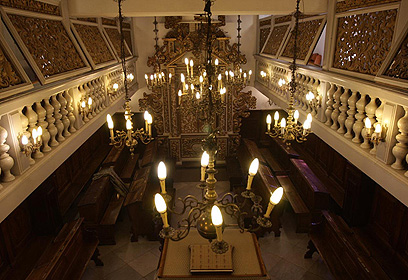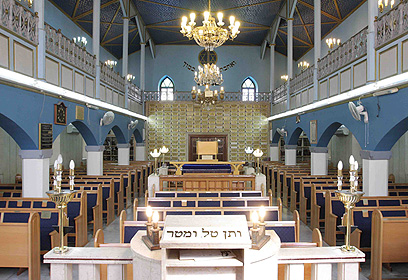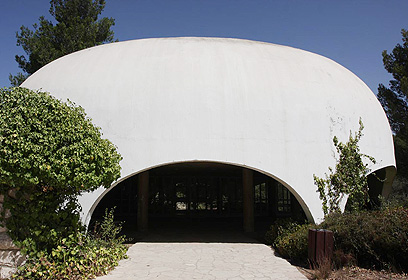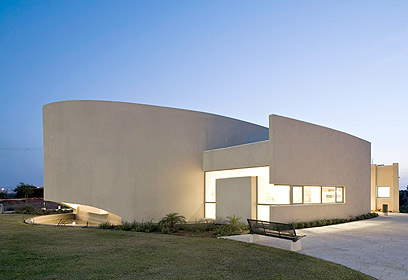
Israel's most beautiful synagogues – part 1
Ahead of Yom Kippur, Ynet asks 10 leading architects to select the 10 most beautiful and special temples in Jewish state, each with its own character and beauty. Here is the first article in this festive project
As part of a special and festive project, Ynet asked 10 leading architects to select a synagogue they are particularly fond of. The truth is we didn't believe we could find so many.
We are proud to present the project's first five synagogues, each accompanied by a picture, a description of the structure written by the selecting architect, and an ID including details about the nature of the prayers at each site.
1. Cymbalista Synagogue, Tel Aviv
_g.jpg)
Photo: Yaron Brener
About the structure
The Cymbalista Synagogue and Jewish Heritage Center at Tel Aviv University were planned by Swiss architect Mario Botta.
From the outside, the building looks like "binoculars" – two tubes made of "bricks" from a special material brought from Asia, in a warm and pleasant color. The two round tubes emerge from square bases, which are the halls of convergence.
The building has two halls separated by the entrance, creating a sort of bipolarity between the prayer hall turning east and the study hall turning west.
In the prayer hall the worshippers sit in layouts facing each other, both turning to the axis connecting the entrance to the Holy Ark. The Ark is surrounded by an alabaster "ring" bringing light into the prayer hall.
Above the synagogue is a sort of canopy connecting to the external tube and shadowing the internal hall. The entire building is unconventional and does not look like a synagogue neither on the outside nor on the inside.
- Selected by Prof. David Cassuto, a lecturer at the Ariel University Center's School of Architecture, who specializes in planning synagogues. His works include the Maalot Synagogue behind the President's Residence and the Yechaveh Daat Synagogue built for the son of Rabbi Ovadia Yosef.
ID
Prayer times: As the synagogue serves the campus, it is only open five days a week. On weekends and holidays, when the campus is closed, the synagogue is not open to the public. On weekdays, the morning prayer is held at 7:30 am. The first quorum of the afternoon prayer takes place at 1:30 pm and the second quorum at 1:55 pm. The evening prayer is held according to sunset times.
Prayer leader: No regular cantor.
Version: According to the cantor.
Cost: None.
Number of worshippers: During the school year, 40 to 50 worshippers gather in every quorum. The largest quorums are held during the afternoon prayer ("minha") and are also attended by women.
Women's gallery: Located on the same floor as the men's gallery, behind a screen.
Accessible to disabled people: Yes.
2. The Italian Synagogue, Jerusalem

Photo: Gil Yohanan
About the structure
The Italian Synagogue is located at the U. Nahon Museum of Italian Jewish Art on 27 Hillel Street. It was "brought" from the Italian town of Conegliano in 1952, after the local authority had planned to destroy it.
The building is admirable, and simply beautiful. The importance of the structure is the space, which is almost reminiscent of the internal space of a human being due to its appearance as two poles connected by one axis.
The Holy Ark is located on the east, and the stage is on the west. The seats are organized between them, with the worshippers sitting on two parallel layouts, each facing the connecting axis.
The synagogue's furniture is special and the walls are covered with cherry tree plating. The women's gallery grilles are carved in wood and can be lifted, and they enable the women to freely observe what is taking place in the men's gallery.
- Selected by architect David Resnick, an Israel Prize laureate whose works include the Givat Ram campus synagogue and the Yad Kennedy memorial.
ID
Prayer times: On Yom Kippur Eve the afternoon prayer is held at 1 pm and the "Kol Nidrei" prayer at 5 pm. On the day of Yom Kippur, the morning prayer begins at 7:15 am, and an additional prayer is held at 11:50 am. The prayer ends at around 1:50 pm and is followed by a short break until the afternoon prayer, which begins at 2:05 pm. The closing prayer is held at 4:50 pm and the evening prayer at 5:38 pm.
During the week no prayers are held at the synagogue, and it serves as part of the Museum of Italian Jewish Art. On Shabbat and holidays there is a regular quorum. The Shabbat morning prayer begins at 8 am and ends at around 11:15 am.
Prayer leader: Different cantors from the community.
Version: Italian, unique to people of Rome. The version originated in the Land of Israel, before the destruction of the Second Temple.
Cost: The synagogue is open to all worshippers, but one must take into account that it is quite crowded during the holidays.
Number of worshippers: The synagogue has room for some 130 worshippers, and is full on Shabbat. On Yom Kippur a double number of people arrive, and an additional quorum is held at the museum halls, which also have Torah scrolls and Holy Arks.
Women's gallery: Located above the men's gallery.
Accessible to disabled people: No, but there is a plan to build an elevator.
3. Ohel Yaakov Synagogue, Zichron Yaacov

Photo: Ido Erez
About the structure
The Ohel Yaakov Synagogue in Zichron Yaacov, located on 7 Hanadiv Street, is an ancient temple which gives a notion of the good old Land of Israel. It was built in 1886 by Baron Edmond de Rothschild in memory of his father Yaakov, and is extremely authentic.
The synagogue represents tradition and continuity, which are well associated with Judaism.
In general, I feel ancient synagogues have an added value. They give the feeling that you belong to something which took place a long time ago, making you feel like you are part of history. Passed down through generations.
The synagogue is quite big, but not huge. This is true from a religious-perceptional aspect: One must be alone with God, and this may be somewhat difficult in grandiose buildings.
Its rectangular design does not represent a breakthrough in terms of genres, but the synagogue has a holiness of spirits which have passed through it and it houses ancient feelings.
- Selected by architect Ilan Pivko, whose works include Ramat Gan's Garden Tower and the Jaffa Sea Shell residential complex
ID
Prayer times: The Yom Kippur morning prayer is held at 7 am, on Shabbat at 8 am, and throughout the rest of the week at 6 am.
Prayer leader: During the Days of Awe (between Rosh Hashana and Yom Kippur), cantors Rabbi Raffi Menat and Gershon Steinkohl will lead the prayer. Throughout the year, the members of the synagogue pray, but once a month on Shabbat, a cantor is brought in – often someone studying in a cantors' school.
Version: Ashkenazi.
Cost: NIS 350 ($101), but there's room for guests.
Number of worshippers: On Yom Kippur the synagogue is full (250 worshippers). On Shabbat there are some 100 worshippers. On weekdays about 15 worshippers arrive for the morning prayer and 30 to 40 attend the afternoon and evening prayers.
Women's gallery: Gallery floor, on three sides.
Accessible to disabled people: Yes.
4. Givat Ram synagogue, Jerusalem

Photo: Gil Yohanan
About the structure
The synagogue at the Hebrew University's Givat Ram campus was planned by David Resnick (together with Heinz Rau) in 1956. Reznik wrote in his book, "Before my eyes I saw a building on the crossroads, as a cover of one's mood" (from a conversation with Yaakov Malkin).
The synagogue looks like a inverse dome, deprived of air and light. The place conveys a great experience. Upon entering the place, one loses sense of direction. The entry is from below and everything is sealed. It's an extremely strong experience.
The synagogue has "architectural significance" – a clear expression of the place's significance. The immediate feeling is of a place of convergence leading to elation.
This is undoubtedly one of the first temples mentioned when thinking about special synagogues.
- Selected by architect David Nofar, whose works include the Bar-Ilan University Law School and the Ashkelon Congress Center.
ID
Prayer times: Due to the synagogue's remoteness from the campus' study and work building, prayer quorums are seldom held at the synagogue. When this does happen, the morning prayer begins at 6:45 am and the evening prayer is held at the end of the school day. No prayers are held on Yom Kippur.
Prayer leader: A different person each time, "all equal in the eyes of God."
Version: According to the cantor.
Cost: None.
Number of worshippers: A few dozens.
Women's gallery: Located on the same floor as the men's gallery, with a wooden screen.
Accessible to disabled people: Yes.
5. Megillat Or Synagogue, Caesarea

Photo: Amit Goren
About the structure
Caesarea's Megillat Or Synagogue in neighborhood 13 is built in circles. The building is unique and built as a spiral, like a curl. The structure carries a new architectural message, and the entire synagogue appears to be rising up like a spring.
The motive guiding the designers, from the Knafo Klimor Architects office, was the shape of a scroll. The building was planned as a spiral creating a gradual shift from a weekday to Shabbat, with the outside space directly confined with the prayer hall. The final result undoubtedly reflects the concept it was based on.
- Selected by Hedva Almoz of the Binyan Vediur (building and housing) magazine.
ID
Prayer times: Yom Kippur's "Kol Nidrei" prayer is held at 5 pm, the morning prayer begins at 8 am (for about four and a half hours), and the closing prayer takes place at 4:40 pm. On weekdays the morning prayer is held at 8 am.
Prayer leader: This is the second year two cantors, who are friends, will lead the prayer – Zamir Malachi (Ashkenazi version) and Zohar Tshuva (Sephardic version). The two combine their prayer versions, and the result is fascinating. The prayer is filled with songs in order to bring close those who are not familiar with the prayers as well.
Version: A combination of the variety of versions available in Israel, dubbed "the Land of Israel version."
Cost: There is room for all those wishing to pray. A chair can be "purchased" for a minimal sum of NIS 200 (about $58).
Number of worshippers: Some 300 worshippers arrive on Yom Kippur for the "Kol Nidrei" and closing prayers. On a regular Shabbat, some 60 worshippers arrive, and about 150 attend celebrations.
Women's gallery: Located on the same floor as the men's gallery, so that women can feel part of the prayer rather than just observing it from above. Its size is about half the size of the men's gallery.
Accessible to disabled people: Yes.
Yael Eichenwald contributed to this story










